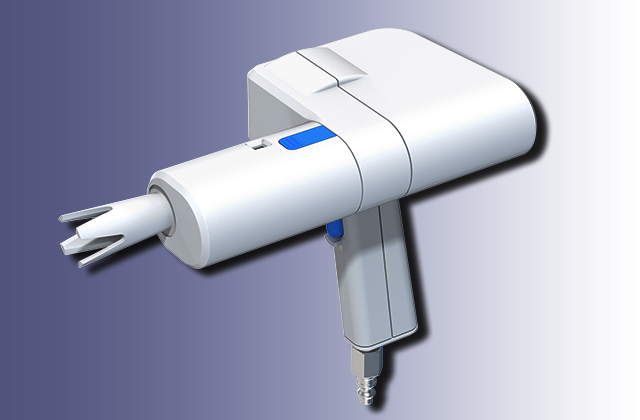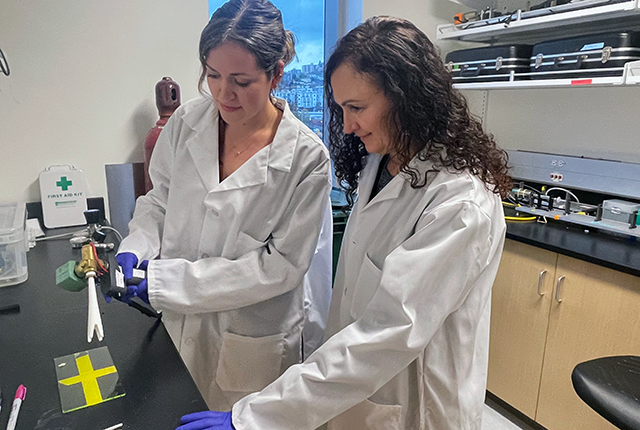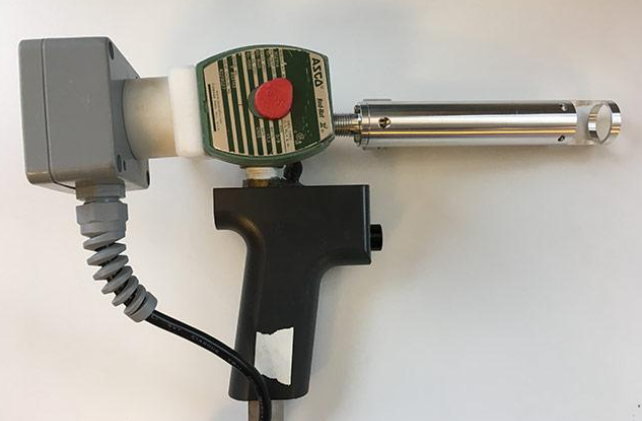
'Gene gun' aims to make universal flu vaccine possible
A device that shoots DNA directly into cells appears to overcome problems that have limited the effectiveness of DNA vaccines.Media Contact: Leila Gray - 206-475-9809, leilag@uw.edu

A “gene gun” that blasts DNA directly into cells will be used to test a universal influenza vaccine in a clinical trial slated for next year. The unique vaccine delivery system was developed by Deborah Fuller, a professor of microbiology at the University of Washington School of Medicine.
Fuller said she got the idea while working for a biotech company that was using the technology to insert genes into plants.
“Some of my colleagues and I began to ask why, if you could shoot genes into plants, why not people?” she said.
DNA vaccines work by introducing genes in cells that code for microbial proteins the immune system will recognize as foreign. Such proteins, called antigens, prompt the immune system to generate cells that will respond quickly if a microbe bearing those antigens infects the body.

For this to happen, however, a complex, multistep process must ensue. First, the DNA in the vaccine must get into the cell and enter the nucleus so its genetic instructions can be read. Next, the cell must produce and properly process the proteins. Finally, the cell must move the proteins to its surface so immune cells can be activated.
Various strategies have attempted to get DNA vaccines into cells, such as directly injecting DNA into muscle and using electric fields to open pores in the cell membranes. Generally, though, the uptake of DNA via these methods has been poor and the immune responses generated by the vaccines has been weak.
To get around the uptake problem, the vaccine system designed by Fuller and colleagues uses a jet of gas traveling at the speed of sound to shoot gold microparticles coated with the DNA directly into skin cells. The microparticles measure just 1 micron across, but provide enough heft needed to carry the vaccine DNA into the cells.
Because the DNA is shot directly into skin cells, the dose required to elicit an immune response is far lower than that needed for vaccines injected into muscle. This is because the skin contains cells that specialize in processing and presenting foreign proteins. These cells are especially effective in stimulating a strong immune response.

In the case of the universal flu vaccine, Fuller and her colleagues have included genes for antigens that don’t vary among different flu strains. They are so important for the virus to survive that they remain essentially unchanged from strain to strain and over time. Including these essential, conserved proteins that all strains seem to require makes it more likely that a strain will be recognized by a vaccinated immune system.
To generate a more robust immune response, the vaccine also carries instructions for a stimulatory protein called interleukin 12, which increases activation of the immune cells responding to the vaccine.
In animal studies, the vaccine has shown effectiveness against a range of influenza strains that cause disease in humans, as well as avian and swine flu strains. Those are of particular concern because they can cross into humans and potentially cause pandemics.
If shown in clinical trials to be effective in humans, such a universal flu vaccine could reduce the need for annual flu vaccines and be deployed rapidly, if a new pandemic strain emerged.
Unlike liquid vaccines, DNA vaccines delivered by the gene gun are a stable, dry powder that is easily manufactured, packaged and can be stored at room temperature. This would make them easier to use in under-resourced regions globally, Fuller said.
“Currently our main focus is on the universal flu vaccine,” she said, “but we have a large number of other vaccines we are exploring, including a vaccine for hepatitis B, a vaccine against Valley Fever, which would be the first vaccine against a fungus, and a vaccine to treat melanoma.”
The gene gun could be used to administer a wide variety of vaccines including either DNA- and RNA-vaccines for prevention of infectious diseases or for treatment of chronic diseases including cancer.
The gene gun is being refined by the Seattle biotech company, Orlance, a UW spinout, which plans to conduct the first phase I clinical trial of this vaccine candidate.
Written by Michael McCarthy
For details about UW Medicine, please visit https://uwmedicine.org/about.